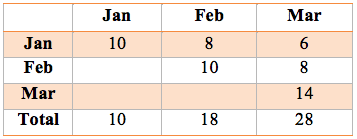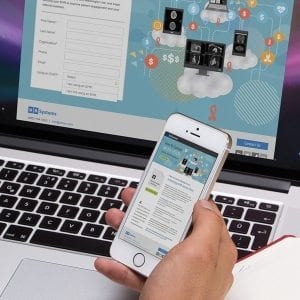In recent months, the digital marketing ecosystem has shown that marketers are reallocating their budgets for 2017. A few leading factors that have resulted in this shift attribute to mobile targeting updates by Google, conversion optimization, and changes in consumer behavior, all of which contribute to improving brand-customer relationships.
Customers value the brand experience over everything else. Looking back on 2016, many changes and updates in digital marketing tactics, as well as technology, are backing this very idea that customers are less concerned about any one particular part of a brand’s marketing tactic. Instead, customers are more concerned about a brand’s entire omnichannel experience. Below we have presented findings and insights on how we, as marketers, can improve our marketing initiatives and budgets for 2017.
Creating a Memorable User Experience on Mobile for Your Brand
These days, we don’t go online. Instead, we live online. The introduction of handheld mobile devices has changed how we interact with one another and how we buy products. We expect immediacy, set high expectations, and use our devices as an extension of our thoughts.
We humans produce between 50,000-70,000 thoughts per day. So, if one those thoughts are a question, we tend to seek immediate answers. We turn to a friend, family, or, more often than not, Google for an answer. We then mull the idea in our head, continue to consult with others, and conduct more research before taking action. Now let’s assume all of the above takes place on a mobile or desktop, or a combination of both. You can see it starts to get confusing. For brands, they no longer have a one-route buying process anymore.
For marketers, the evolvement of mobile-centric marketing can easily result in wasted money as they desperately try to track, analyze, and hopefully optimize their customer buying experience. Knowing this is a challenge for marketers, Google is finding ways to better control the entire process of converting customers through mobile so that brands can better connect with their customers.
Using a few of Google’s tools like the Mobile-Friendly Test or Page Speed Insights can help target what is and is not working for your users’ experience on mobile. For mobile retailers, this is imperative in finding the best way to make your customers experience with your brand a memorable one. Need a benchmark? Google Shopping to check out should no longer than 2 minutes.
TIP: Tracking All Types Of Conversions
Good news for omnichannel marketers is that Google helps you track all sorts of conversions. See below for a list of what kinds of conversions are available to you through Google Adwords and which ones are the most important to track.
- Online Sales
- App Downloads
- Phone Calls
- Cross-Device Conversions
- Estimated In-Store Purchases
TIP: Optimizing All Types of Conversions
Now that you know what conversions to track, here is a list of ways you can optimize your ads.
- Device-Level Bidding: Now make bid adjustments to any devices.
- Cross-Device Retargeting (Beta): Now you can remarket across different devices that performed well in the past on any specific time in a day.
- Expanded Text Ads: Text ads now have more prominent headers as well as longer description lines. These ads work across all devices.
- Price Extensions: Now you have the ability to list a range of different products. This can push competitor ads down the page on mobile.
- Visual Sitelinks (Beta): You have to opt-in to try this option. Instead of having normal site links that redirect visitors to websites after clicking an ad, the new interface is showing them in a card carousel format. So far those users in beta are already experiencing an 8-12% conversion increase.

The best part of Google Adwords’ recent improvements is that they are all mobile-responsive. In addition, Google Search also added a fourth line for text ads on mobile. This means that more ads are showing above-the-fold, pushing organic posts further down in search results. Google Adwords users are already seeing an increase in paid mobile traffic because of this.
Businesses that are not using Google Adwords as a paid advertising tactic and, instead, are focusing on SEO, should keep this in mind as they start building out their 2017 marketing plan. Paid advertising on mobile through Google Adwords isn’t the end all be all, but being aware of your options as a marketer can help organize your marketing efforts.
Looking to Customer Cohorts & Segmentation
Whether you are using paid advertising or not, marketers always need to start any marketing plan with a clear understanding of who their customer is. In more cases than not, marketers are only able to work with a ballpark demographic profile. Marketers may have an extensive demographic profile on their customers but aren’t able to effectively narrow down key behavioral traits to increase conversions and revenue. Instead, they spend a lot of money testing and getting nowhere.
What we have found is that people have trouble figuring out how to prioritize their customer data. The silver lining is, that it’s not as hard to cohort and segment customer data effectively as it seems. As long as you keep it simple, marketers can take any data, big or small, and create an effective marketing plan to maximize conversions.
Knowing The Difference Between Cohort & Segmentation
First, we need to understand that a cohort is a group of people banded together and act as a group and a segment is a division of that group. Typically you start with a cohort, and then you begin to segment accordingly.
For example, lets’ say there is a website that is selling subscription access to instructional videos. These are the types of questions we need to ask:
- What is my revenue per subscriber?
- Which is my most profitable channel?
Then, we can start to break down the cohort by time (ie. Month). The below table shows that of the 10 people that signed up in January and 4 cancellations occurred by March. Using the same logic for the February and March, a total of 32 people subscribed and 6 people canceled their subscription in the first quarter. This is considered the Churn.

Using this simple process of analyzing your cohorts, you will be able to see how effective your marketing tactics are over time. This works for Facebook Ads, Google Adwords, Email, and more. Here are a few key performing indicators you can determine before segmenting your data:
- First-time purchasers
- Trial start month
- Subscription start month
- Subscription cancellation month
- Cancelled Users
Once your cohorts are defined, then you can begin to segment your customer data and retarget them with personalized content. This helps extend the brand experience and improves the brand-to-customer relationship overtime.
Retention Marketing Is All About The Customer
Using the right blend of data, strategy, and technology, marketers have the tools and ability to acquire, convert, grow, retain, and win back customers in one seamless omnichannel journey. For 2017, understanding the customer is the most important difference between you and the competition. All else will fall into place and instead of always trying to catch up with the digital marketing ecosystem, you can evolve with it.









